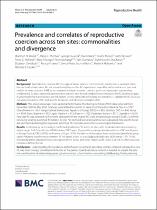| dc.description.abstract | Background Reproductive coercion (RC) is a type of abuse where a partner asserts control over a woman’s reproductive
health trajectories. Recent research emphasizes that RC experiences may differ within and across low- and
middle-income countries (LMICs), as compared to higher income contexts, given social pressures surrounding
childbearing. To date, nationally representative surveys have lacked comprehensive measures for RC, leading to gaps
in understanding its prevalence and risk factors. Across eight LMICs (10 sites), we aimed to (1) validate the RC Scale; (2)
calculate prevalence of RC and specific behaviors; and (3) assess correlates of RC.
Methods This analysis leverages cross-sectional Performance Monitoring for Action (PMA) data collected from
November 2020 to May 2022. Analyses were limited to women in need of contraception (Burkina Faso n = 2767;
Côte d’Ivoire n = 1561; Kongo Central, Democratic Republic of Congo (DRC) n = 830; Kinshasa, DRC n = 846; Kenya
n = 4588; Kano, Nigeria n = 535; Lagos, Nigeria n = 612; Niger n = 1525; Rajasthan, India n = 3017; Uganda n = 2020).
Past-year RC was assessed via five items adapted from the original RC Scale and previously tested in LMICs. Confirmatory
factor analysis examined fit statistics by site. Per-item and overall prevalence were calculated. Site-specific bivariate
and multivariable logistic regression examined RC correlates across the socioecological framework.
Results Confirmatory factor analysis confirmed goodness of fit across all sites, with moderate internal consistency
(alpha range: 0.66 Cote d’Ivoire–0.89 Kinshasa, DRC/Lagos, Nigeria). Past-year reported prevalence of RC was highest
in Kongo Central, DRC (20.3%) and lowest in Niger (3.1%). Prevalence of individual items varied substantially by geography.
Polygyny was the most common RC risk factor across six sites (adjusted odds ratio (aOR) range: 1.59–10.76).
Increased partner education levels were protective in Kenya and Kano, Nigeria (aOR range: 0.23–0.67). Other assessed
correlates differed by site.
Conclusions Understanding RC prevalence and behaviors is central to providing woman-centered reproductive care.
RC was most strongly correlated with factors at the partner dyad level; future research is needed to unpack the relative
contributions of relationship power dynamics versus cultural norms surrounding childbearing. Family planning | en_US |

